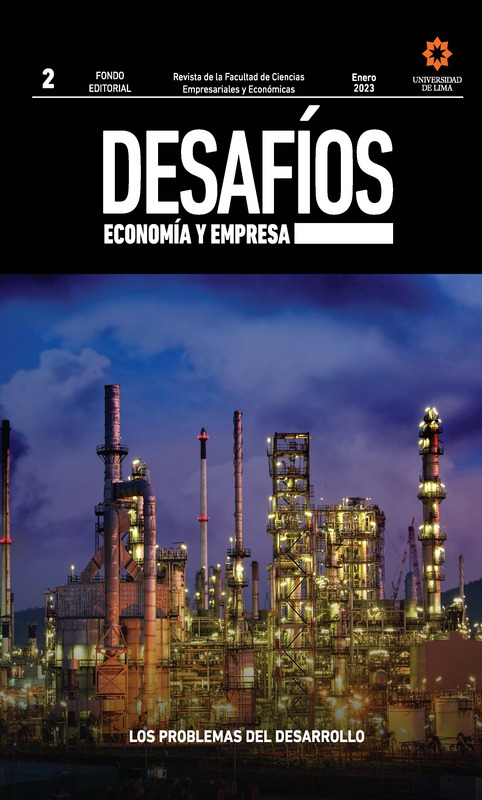Tipo de cambio Yuan-DEG después de la entrada del Yuab en la canasta de DEG
DOI:
https://doi.org/10.26439/ddee2022.n002.5572Palabras clave:
Yuan, US Dollar, nominal effective exchange rate, real effective exchange Rate, international monetary systemResumen
El sistema monetario Internacional aparece en una nueva forma desde que el yuan se incluyó en la canasta de monedas de los derechos especiales de giro (DEG) con una ponderación solo superada por el dólar estadounidense y el euro. En la canasta de DEG, el tipo de cambio del yuan con canastas de divisas se ha calculado diariamente con un tipo de cambio de libre flotación, por lo que China ha tenido que reformar su mecanismo de tasa de cambio y su estructura de mercado de capitales. En este nuevo escenario, se examinan las interrelaciones entre los tipos de cambio de Yuan-DEG, Yuan-Dólar estadounidense, el tipo de cambio efectivo nominal (TCEN) y el tipo de cambio efectivo real (TCER) del yuan para encontrar cualquier influencia sobre YuanDEG debido a cambios en Yuan-Dólar estadounidense, TCEN y TCER, respectivamente. Se aplica el filtro de regresión de descomposición de Hamilton de Yuan-DEG desde 2017m1 a 2021m7 y se encuentra que la tendencia cíclica de Yuan-DEG tiene forma de U inversa y su patrón cíclico constituye variaciones estacionales. Asimismo, se usa la prueba de cointegración de Johansen y el modelo de vector de corrección de errores (VECM) y se halla que el Yuan-DEG tiene causalidades a largo plazo desde el YuanDólar estadounidense y el TCEN del yuan. Además, el Yuan-Dólar estadounidense, el TCER y el TCEN del yuan tienen causalidades a corto plazo desde el Yuan-DEG.
Descargas
Referencias
Bhowmik, D. (2020a). Determinants of Nominal Effective Exchange Rate (NEER) and Real Effective Exchange Rate (REER) of Chinese renminbi (RMB). London Journal of Research in Humanities and Social Sciences, 20(15), 47-64.
Bhowmik, D. (2020b). Patterns of trends and cycles of Nominal Effective Exchange Rate and Real Effective Exchange Rate of Chinese renminbi. London Journal of Research in Humanities and Social Science, 20(15), 47-64.
Box, G. E. P., & Jenkins, G. M. (1976). Time Series Analysis, Forecasting and Control. Holden-Day.
Das, S. (2019). China’s evolving exchange rate regime. International Monetary Fund, Working Paper 19/50.
Dickey, D. A., & Fuller, W. A. (1979). Distribution of the estimators for autoregressive time series with a unit root. Journal of the American Statistical Association, 74(366), 427-431.
Estrella, A. (2007). Extracting business cycle fluctuations: What do time series filters really do? Federal Reserve Bank of New York, Staff Report 289.
Frankel, J. A., & Wei, S. J. (1994). Yen bloc or dollar bloc? Exchange rate policies of the East Asian economies. En T. Ito y A. Krueger (Eds.), Macroeconomic Linkages: Savings, Exchange Rates and Capital Flows (pp. 295-329). University of Chicago Press.
Haldane, A. G., & Hall, S. G. (1991). Sterling’s relationship with the dollar and the deutschemark: 1976-89. The Economic Journal, 101(406), 436-443.
Hamilton, J. D. (2018). Why you should never use the Hodrick-Prescott Filter. The Review of Economics and Statistics, 100(5), 831-843.
Hung, H. F. (2015). RMB inclusion into SDR: Hyperbole and reality. Columbia University Blog Press. https://www.cupblog.org/2015/12/01/rmb-inclusion-into-sdr-hyperbole-and-reality/
Ito, H., & McCauley, R. (2016). Rescaling global imbalance: Key currency zones and renminbi management. Technical Report. https://www.tcd.ie/Economics/assets/pdf/Seminars/20162017/Hiro%20Ito.pdf
Johansen, S. (1988). Statistical analysis of cointegration vectors. Journal of Economic Dynamics and Control, 12(2-3), 231-254.
Narasimhan, C. R. L. (2015). Implications of yuan’s rise. The Hindu, November 22.
Qiqi, Y. (2020). A brief analysis on Chinese exchange rate regime. [Graduate Thesis]. Luiss Guido Carli University.
Srinivas, V. (2018). Rise of China in the International Monetary System and implications for other economies. Chennai Centre for China Studies (C3S) and Southern India Chamber of Commerce and Industry (SICCI), Tamil Nadu, India.
Suzuki, T. (2016). The renminbi exchange rate reform and its implications for Asian markets. China Quarterly of International Strategic Studies, 2(4), 485–506.
Wald, A. (1943). Test of statistical hypotheses concerning several parameters when the number of observations is large. Transactions of the American Mathematical Society, 54(3), 426-482.
Wolf Jr., C. (2016). China’s yuan as a reserve currency: Boon or bane for the dollar? The Rand Blog, June 3.


